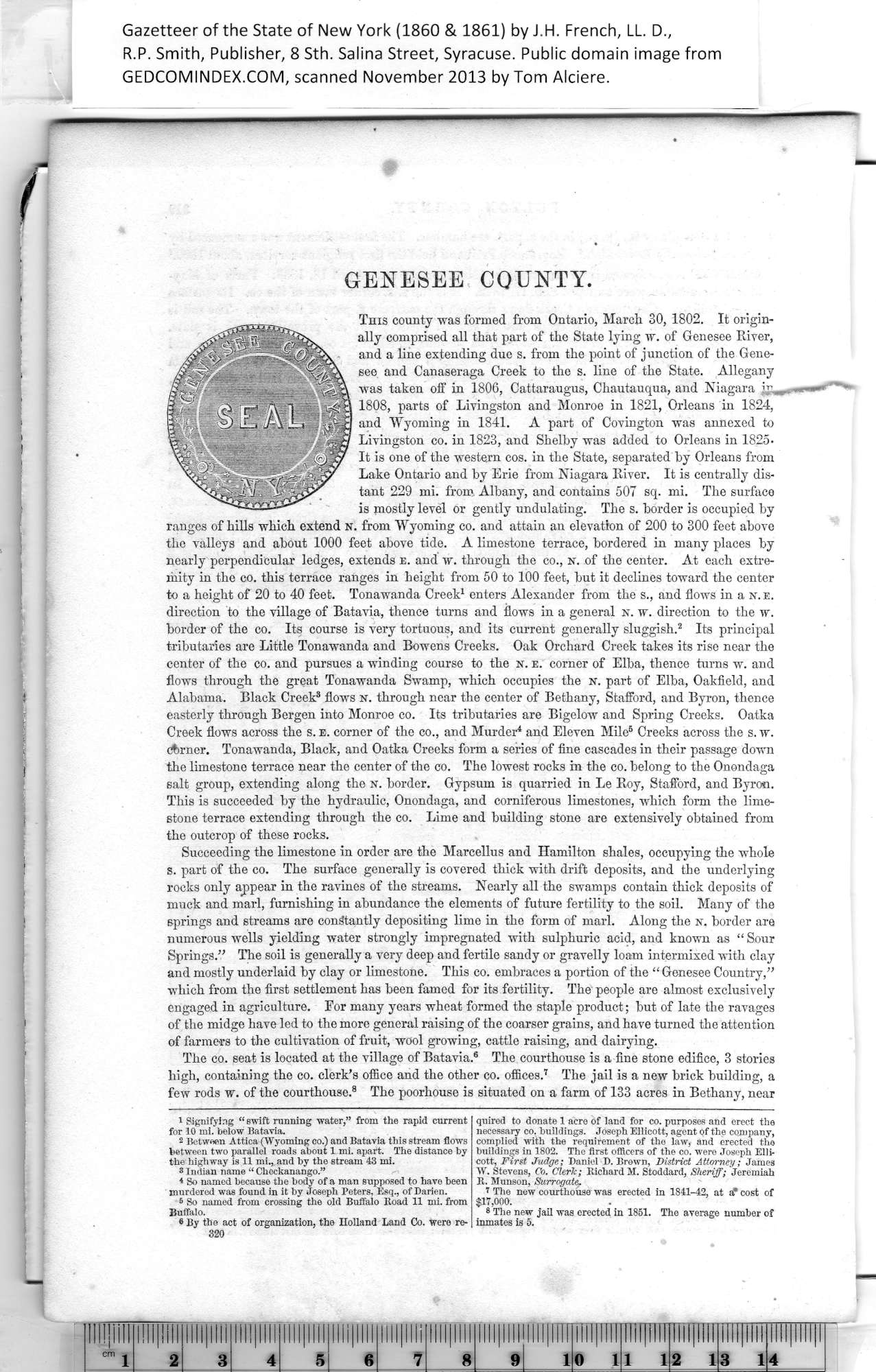|
GENESEE COUNTY.
This county was formed from Ontario, March 30, 1802. It origin¬
ally comprised all that part of the State lying w. of Genesee River,
and a line extending due s. from the point of junction of the Gene¬
see and Canaseraga Creek to the s. line of the State. Allegany
was taken off in 1806, Cattaraugus, Chautauqua, and Niagara
1808, parts of Livingston and Monroe in 1821, Orleans in 1824,
and Wyoming in 1841. A part of Covington was annexed to
Livingston co. in 1823, and Shelby was added to Orleans in 1825.
It is one of the western cos. in the State, separated by Orleans from
Lake Ontario and by Erie from Niagara River. It is centrally dis¬
tant 229 mi. from Albany, and contains 507 sq. mi. The surface
is mostly level or gently undulating. The s. border is occupied by
ranges of hills which extend n. from Wyoming co. and attain an elevation of 200 to 300 feet above
the valleys and about 1000 feet above tide. A limestone terrace, bordered in many places by
nearly perpendicular ledges, extends e. and w. through the co., n. of the center. At each extre¬
mity in the co. this terrace ranges in height from 50 to 100 feet, but it declines toward the center
to a height of 20 to 40 feet. Tonawanda Creek1 enters Alexander from the s., and flows in a n. e.
direction to the village of Batavia, thence turns and flows in a general sr. w. direction to the w.
border of the co. Its course is very tortuous, and its current generally sluggish.2 Its principal
tributaries are Little Tonawanda and Bowens Creeks. Oak Orchard Creek takes its rise near the
center of the co. and pursues a winding course to the n. e. corner of Elba, thence turns w. and
flows through the great Tonawanda Swamp, which occupies the n. part of Elba, Oakfield, and
Alabama. Black Creek3 flows n. through near the center of Bethany, Stafford, and Byron, thence
easterly through Bergen into Monroe co. Its tributaries are Bigelow and Spring Creeks. Oatka
Creek flows across the s. e. corner of the co., and Murder1 and Eleven Mile5 Creeks across the s. w.
cbrner. Tonawanda, Black, and Oatka Creeks form a series of fine cascades in their passage down
the limestone terrace near the center of the co. The lowest rocks in the co. belong to the Onondaga
salt group, extending along the n. border. Gypsum is quarried in Le Roy, Stafford, and Byron.
This is succeeded by the hydraulic, Onondaga, and corniferous limestones, which form the lime¬
stone terrace extending through the co. Lime and building stone are extensively obtained from
the outcrop of these rocks.
Succeeding the limestone in order are the Marcellus and Hamilton shales, occupying the whole
s. part of the co. The surface generally is covered thick with drift deposits, and the underlying
rocks only ajppear in the ravines of the streams. Nearly all the swamps contain thick deposits of
muck and marl, furnishing in abundance the elements of future fertility to the soil. Many of the
springs and streams are constantly depositing lime in the form of marl. Along the n. border are
numerous wells yielding water strongly impregnated with sulphuric acid, and known as “ Sour
Springs.” The soil is generally a very deep and fertile sandy or gravelly loam intermixed with clay
and mostly underlaid by clay or limestone. This co. embraces a portion of the “ Genesee Country,”
which from the first settlement has been famed for its fertility. The people are almost exclusively
engaged in agriculture. For many years wheat formed the staple product; but of late the ravages
of the midge have led to the more general raising of the coarser grains, and have turned the attention
of farmers to the cultivation of fruit, wool growing, cattle raising, and dairying.
The co. seat is located at the village of Batavia.4 The courthouse is a fine stone edifice, 3 stories
high, containing the co. clerk’s office and the other co. offices.7 The jail is a new brick building, a
few rods w. of the courthouse.8 The poorhouse is situated on a farm of 133 acres in Bethany, near
|
quired to donate 1 acre of land for co. purposes and erect the
necessary co. buildings. Joseph Ellicott, agent of the company,
complied with the requirement of the law, and erected the
buildings in 1802. The first officers of the co. were Joseph Elli¬
cott, First Judge; Daniel D. Brown, District Attorney; James
W. Stevens, Co. Clerk; Bichard M. Stoddard, Sheriff; Jeremiah
B. Munson, Surrogate.
1 The new courthouse was erected in 1841-42, at a* cost of
$17,000.
3 The new jail was erected in 1851. The average number of
inmates is 5. |
1
Signifying “ swift running water,” from the rapid current
for 10 mi. below Batavia.
2
Between Attica (Wyoming co.) and Batavia this stream flows
between two parallel roads about 1 mi. apart. The distance by
the highway is 11 mi., and by the stream 43 mi.
3
Indian name “ Checkanango.”
4
So named from crossing the old Buffalo Iioad 11 mi. from
|
